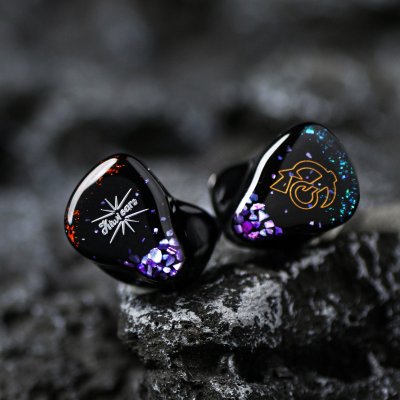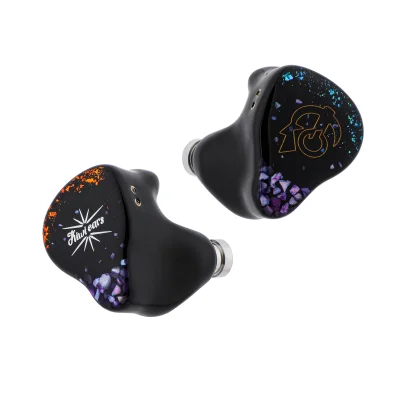Kiwi Ears x HBB Punch and Yu9 Que use 1DD+2BA+2EST and 1DD+3BA driver setups respectively. Kiwi Ears x HBB Punch costs $450 while Yu9 Que costs $409. Kiwi Ears x HBB Punch is $41 more expensive. Yu9 Que holds a clear 0.5-point edge in reviewer scores (7.7 vs 8.1). Yu9 Que carries a user score of 8.5. Yu9 Que has slightly better bass with a 0.4-point edge, Yu9 Que has significantly better mids with a 1.5-point edge, Yu9 Que has better treble with a 0.9-point edge, Yu9 Que has better dynamics with a 0.6-point edge, Yu9 Que has significantly better soundstage with a 1.3-point edge, Yu9 Que has slightly better details with a 0.3-point edge and Yu9 Que has slightly better imaging with a 0.3-point edge.
Insights
| Metric | Kiwi Ears x HBB Punch | Yu9 Que |
|---|---|---|
| Bass | 7.9 | 8.2 |
| Mids | 6.8 | 8.3 |
| Treble | 7.1 | 8 |
| Details | 7.5 | 7.8 |
| Soundstage | 6.8 | 8.1 |
| Imaging | 7.6 | 7.9 |
| Dynamics | 7.2 | 7.8 |
| Tonality | 7.8 | 8.3 |
| Technicalities | 7.3 | 8 |
Kiwi Ears x HBB Punch Aggregated Review Score
Average Reviewer Scores
Average Reviewer Score:
7.7Strongly Favorable
Yu9 Que Aggregated Review Score
Average Reviewer Scores
Average Reviewer Score:
8.1Very Positive
Reviews Comparison
Kiwi Ears x HBB Punch reviewed by Paul Wasabii
Youtube Video Summary
Kiwi Ears x HBB Punch aims for a proper basshead profile with a large bass shelf, lowered treble and vocals that sit neatly "in the pocket". The 1DD + 2BA + 2EST setup is tuned to be turned up, so the bass rises while mids and treble climb more slowly, keeping fatigue down and preserving clarity. A slight mid-bass bump adds fullness while sub-bass delivers the ear-shaking weight fans of old-school rap expect.
Technical execution is solid: the hybrid approach brings better layering, separation and staging than typical bass-centric sets, and volume scaling stays controlled over a wide range. Bass favors quantity and rumble over absolute tightness or slam; mids are slightly recessed yet remain clear, and treble is deliberately tamed to avoid glare. Compared with more balanced flavors, this is the more twisted, bass-forward option that shines when heavy low end is the priority.
Paul Wasabii Youtube Channel
Buy Kiwi Ears x HBB Punch on Linsoul
Ad
Price: $449
Buy Kiwi Ears x HBB Punch on Linsoul
Yu9 Que reviewed by Paul Wasabii
Youtube Video Summary
At ~$400, YU9 Audio Que sets a new bar for the bracket: a 1DD+3BA hybrid with a modest bass shelf, slightly forward mids, and linear treble extension that sounds more speaker-like than typical IEMs. The presentation is exceptionally polished and quiet-backgrounded, yielding crisp separation, convincing imaging, and staging in depth, width, and height that resembles far pricier gear.
The low end brings tactile mid-bass impact with deep, controlled sub-bass, pairing naturally with that extended, peak-free top end; the result is a true playlist killer across EDM, rock, vocal, and classical. Nitpicks exist: mids can sit a touch forward depending on track and the set rewards a slightly higher volume and a secure, deeper fit, while V-shape fans may find it too boring.
Compared with favorites like Dusk, Cadenza 4, and Volume S, Que keeps their strengths but fixes common complaints by delivering fuller bass weight, cleaner openness, and more realistic attack and dynamics. It does not need giant-killer claims to stand out; at this price it is simply class-leading.
Paul Wasabii Youtube Channel
Kiwi Ears x HBB Punch reviewed by Jays Audio
Youtube Video Summary
Kiwi Ears x HBB Punch hits the brief for a true bass-head endgame: sub-bass digs deep with rumble, mid-bass has heft and texture, and the slam is downright physical—yet staging stays open and never claustrophobic. Vocals remain balanced and non-congested (not a vocal specialist, but far from muddy), while the EST treble is extended and a touch lively for contrast, avoiding the overly smoothed top end common to big-bass sets. With ASLA Sedna tips, the presentation gains extra air, keeping the thunderous low end from overwhelming the mix.
Against peers, Punch favors fun and impact over micro-detail: sets like Titans/Origin run cleaner mids and tighter bass, but offer less sheer low-end quantity; Punch gives more of what bass lovers actually want for hip-hop, rock, R&B, and pop. Compared with other bassy options (e.g., the “Deuce”), Punch steps up with meatier mid-bass tactility, a more airy treble, and a wider sense of space; versus Symphonium Meteor, it trades warm, airy mids for greater sub-bass dominance and slam. For listeners who found Hype 4 / T-Pros bass “just right,” Punch may be too much; for anyone chasing quality + quantity down low, it’s the easy pick—and can even be EQ’d down to a more neutral target while keeping that satisfying texture.
Jays Audio Youtube Channel
Yu9 Que reviewed by Jays Audio
Youtube Video Summary
YU9 Que presents a balanced, almost neutral tuning with a tasteful touch of mid-bass for warmth and punch. Treble is clean and controlled—more clarity than “sizzle”—so detail comes through without harshness, while mids keep vocals natural rather than forward or thin. Technical performance sits in the “solid for the price” camp: separation and imaging are tidy, but not the kind of hyper-etched sparkle that chases wow factor.
In practice, it shines with slower pop, R&B, acoustic and vocal-centric tracks where its coherence and smoothness pay off; those seeking big sub-bass drama or ultra-aerated treble fireworks may find it a touch polite. Versus brighter, more contrasty sets, the Que trades spectacle for musicality and long-session comfort, making value hinge on whether a refined, low-fatigue signature is preferred over maximum excitement at the price point.
Jays Audio Youtube Channel
Kiwi Ears x HBB Punch reviewed by Jaytiss
Youtube Video Summary
The five-driver collab comes in at around $450 (initially closer to $400, even ~$350 with coupons) and feels thoughtfully put together: a playful, divisive faceplate, a slightly large but well-contoured shell with a nozzle that holds tips securely, and flat 2-pin connectors with proper venting. The included cable is soft and pleasant in hand with clear red/blue channel markers, though the chin slider is a bit loose; 3.5 mm and 4.4 mm terminations are available. Comfort is generally solid—there’s a hint of pointiness for sensitive ears, but overall the ergonomics and case/cable package feel right for the price.
Sonically, this is a very bassy tuning that still keeps the mids clean and defined, pulling off that tricky combo of weight and clarity. Sub-bass digs deep, mid-bass stays controlled enough to avoid bloom, and there’s a touch of upper-air “twinkle” (more evident on some rigs than others); treble extension is tasteful rather than aggressive, which some may read as slightly relaxed. It’s also one of the more affordable EST implementations, delivering a bass-forward but detailed presentation that tracks close to target without sounding sterile.
Against peers, it mirrors the HiSenior Mega 5 EST in FR but adds a bit more pizzazz off-graph, while the Mega 5 feels smoother and more polite. Compared with HBB’s own Jupiter, that set feels technically superior and more refined, but also pricier; value swings back to the Punch—especially at coupon pricing—if oodles of sub-bass are the priority. It’s not for neutral-heads, yet as an all-rounder for bass-leaning listeners it checks most boxes with few real faults, earning a confident 92 (S-) for its fun-but-balanced tonality, solid build, and compelling price-to-performance.
Jaytiss Youtube Channel
Yu9 Que reviewed by Jaytiss
Youtube Video Summary
The YU9 Que sports a premium, durable resin shell in pure black with a metallic-feeling faceplate and a comfortable design featuring an anti-tragus catch. While the build itself feels handsome and unique, the included cable is criticized as wimpy and unpleasant, with a strong suggestion to upgrade it. Accessories are deemed solid, including a nice selection of tips and a particularly praised case with a soft, luxurious interior.
Sonically, the YU9 Que earns immense praise for its exceptional tuning, described as clean, resolute, and non-fatiguing. It delivers strong, textured bass that avoids being overwhelming, coupled with extremely well-done upper mids. While not class-leading in technicalities like micro-detail or instrument separation, its tonal balance is considered sophisticated and reminiscent of far more expensive sets like the Annihilator, even surpassing the Monarch MKII in tuning preference. It's highlighted as a fantastic all-rounder with a smooth, agreeable signature suitable for long listening sessions.
Despite its modest single dynamic driver + 3BA configuration and $409 price point, the YU9 Que is declared a very special and unique IEM, worthy of the hype it received. The review concludes it's a price leader and a highly competent package from a small brand, offering outstanding value and a beautiful, well-executed design that makes it an easy recommendation for those seeking a smooth, non-fatiguing sound.
Jaytiss Youtube Channel
Kiwi Ears x HBB Punch reviewed by Head-Fi.org
Yu9 Que reviewed by Head-Fi.org
Kiwi Ears x HBB Punch (more reviews)
Kiwi Ears x HBB Punch reviewed by Audio Amigo
Youtube Video Summary
Kiwi Ears x HBB Punch arrives with the usual KiwiEars presentation: a sturdy case, three sets of silicone tips, and—usefully—replaceable nozzle filters, but not much else for a $450 set. The stock cable feels nice and behaves well, though a modular plug system is missed. Build is solid: 3D-printed resin shells with metal nozzles, light weight, big rear vent, and no pressure issues. Fit is generally secure even on long sessions, but the semi-custom shape can vary ear-to-ear; the tiny-ears test gets a conditional pass. Aesthetics—subtle sparkles and split logos—earned high marks from the “council of ladies,” with an unusually strong compliment rate.
Sonically, this is bass-head tuning done right. Sub-bass rumble and mid-bass thump hit hard yet avoid bloat; kick drums and bass guitars have addictive weight. The mids are warmed by that lift: male vocals gain a darker, huskier tone, while female vocals are the soft spot—still enjoyable, just less pristine than neutral sets. Up top, the Sonion ESTs bring refined sparkle and air without harshness; cymbals are crisp and neatly decayed. Technical chops are strong for the style: low-end texture, clean separation, and convincing stage/imaging. It’s dongle-friendly, though higher output impedance or adapters tilt it warmer and shave some treble air—fun, but not necessarily preferable.
Against peers, the 7Hz x HBB “Alua” echoes the Punch’s DNA at $30 but bleeds more and feels far less refined. A Simgot SuperMix 4 plus a 10–30Ω adapter can mimic a more V-shaped version—huge fun, thinner mids. The FatFreq x HBB Deuce cleans the midrange with a stronger mid-bass tuck but can’t match the Punch’s slam or resolution. Versus the HiSenior Mega5 EST Bass, Punch is the more exciting and bass-forward; Mega5 is smoother and more neutral-leaning. Verdict: a “for bass heads, by bass heads” triumph that minimizes the usual penalties. Accessories are underwhelming and the price will self-select buyers, but on sale near $350 it becomes a killer value. Recommendation: absolutely for bass lovers; others should look to cleaner, mid-centric alternatives.
Audio Amigo Youtube Channel
Kiwi Ears x HBB Punch reviewed by Bad Guy Good Audio
Youtube Video Summary
Built as a tribrid for bassheads, the Kiwi Ears x HBB Punch pairs a muscular dynamic driver with BA mids and Sonion EST treble to deliver a thick, textured low end that slams on 808s, hip-hop, and four/five-string bass guitar. Sub-bass digs deep while mid-bass is elevated, giving kicks real weight and adding satisfying grit to male vocals. A measured 3 kHz rise helps prevent haze, keeping cymbal overtones, guitars, and busy mixes clear.
Tonally, this tuning favors hip-hop, rock, and bass-forward libraries; female vocals can pick up warmth and husk from the mid-bass, making K-/J-pop less ideal as an EDC choice. Technicals are confident: bass texture holds together when pushed, mids remain intelligible, and the upper-treble from the ESTs adds clean shimmer without harshness, with enough headroom to turn up before things unravel.
Beyond sound, the driver selection feels high-quality, crossover work is coherent, and Kiwi Ears’ QA/QC track record inspires trust. Net result: a high-impact, well-sorted bass specialist that rewards listeners seeking visceral slam and rich harmonics—just note that female-forward libraries may prefer a leaner mid-bass profile.
Bad Guy Good Audio original ranking
Bad Guy Good Audio Youtube ChannelKiwi Ears x HBB Punch reviewed by Z-Reviews
Youtube Video Summary
Kiwi Ears x HBB Punch hits with massive sub-bass—“like 19 dB” of rumble—yet the overall vibe stays surprisingly relaxed. The tuning keeps mid-bass in check, so everyday tracks feel calm and almost MTV Unplugged, while a bass-test playlist unleashes a deep, seismic floor. Stage is big and wide but pushes the listener a bit far back; the presentation is spacious, smooth, and slightly held-back in energy rather than foot-tapping or aggressive.
Build and kit are minimalist: a small case, a single set of green silicone tips, a decent cable terminated in 3.5 mm, and shells with blue sparkles and HBB’s logo. Tip-rolling helps—wide-bore and DUNU SS keep things airy, while Render tips (silicone with foam core) maximize seal and bring out the deepest lows—but even then the character stays more chill than thrilling. Driver array is ambitious—1DD + 2BA + 2EST—yet the voicing aims for ease and spread rather than attack and bite, which makes critical listening or quick A/Bs less satisfying.
The sticking point is price. Judged blind on accessories, tuning, and engagement, the set feels like a strong $150–$200 value; discovering a tag around $450 is a shock. As a result, recommendation becomes conditional: worth a look if discounted, if a collector of HBB collabs, or if craving the absolute lowest low end in a relaxed, panoramic package. For most, the unique, sub-bass-heavy serenity and stadium-wide stage are intriguing—but at the asked price, the excitement doesn’t quite match the number.
Z-Reviews Youtube Channel
Yu9 Que (more reviews)
Yu9 Que reviewed by Gizaudio Axel
Youtube Video Summary
Build & accessories: a hybrid 1DD + 3BA set priced around $399 with a spacious zipper case, multiple silicone tips, pouches, cleaning cloth, and shirt clip. The faceplate’s wavy, stone-like texture looks premium, and the shells use a 2-pin connector. The downside is the stock cable: it’s springy, only in 4.4 mm, and feels below the tier. Fit is serviceable but not ideal—the shell isn’t the most ergonomic, the nozzle lacks a lip, and seating a deeper fit can take a moment; once set, stability is good and tips stayed secure in use.
Sound: this isn’t a “new-meta” curve; it’s a unique, lively tuning. Bass is punchy, dynamic, and highly textured—more physical in practice than the graph suggests, with excellent impact and kick-drum authority. An early rise after 1 kHz pushes vocals front and center for an intimate, engaging presentation without tipping into shout. Treble is refined, sparkly, and well-extended: it is a bright set but avoids harshness, peakiness, sibilance, and fatigue, delivering crisp cymbals and defined transients even for rock and metal at any volume. Technicalities are class-leading under $500 with standout detail retrieval and separation; the one wish is a larger soundstage.
Comparisons & verdict: the Elysian Apostle still wins on bass texture/impact, treble refinement, and overall resolution, but the Yu9 Que offers a convincing “Apostle flavor” at a lower price. Versus Elysian Pilgrim, the Que is fuller and bassier, while Pilgrim’s treble is tamer; versus Volume S, the Que is cleaner, brighter, more detailed as the Volume S trends warmer with more neutral treble; against Dusk DSP, Dusk sounds more natural/balanced but the Que feels more fun and technical. Recommended for those who crave clarity, sparkle, and engagement without fatigue; less ideal if treble-sensitive or preferring a warm, relaxed tonality, and worth demoing for comfort. A top contender and serious gatekeeper around $400—final rating: 4.5/5 with a strong recommendation.
Gizaudio Axel original ranking
Gizaudio Axel Youtube ChannelYu9 Que reviewed by Audionotions
Yu9 Que reviewed by Fox Told Me So
Tuning is clean, neutral, and slightly V-shaped: bass is tight, bouncy, and textured; mids sit slightly forward thanks to extra 700 Hz–2 kHz gain, giving vocals a bigger image; treble leans bright with a 4–5 kHz push for clarity, rolling off naturally rather than chasing EST-style air. Sibilance can appear (on “th” or “tsu”), but not harsh.
Stage favors width over depth—impressively wide at the price, with neat, well-ordered placement and strong separation. Resolution is crisp, background clean, every note clearly etched.
Fox Told Me So original ranking
Fox Told Me So Youtube ChannelYu9 Que reviewed by Kois Archive
Youtube Video Summary
Yu9 Que arrives with a surprisingly premium unboxing: a crush-resistant carrying case with plush padding, an IEM pouch, microfiber cloth, cable clip, and two ear-tip sets (standard silicone and more premium liquid silicone). A quirky 3D-printed nameplate with serial number and a faceplate etched in a topographic-map motif give it character. The shell is on the larger, wider side—comfortable for many, but small ears should test fit first. The stock cable is just okay (some memory, no chin slider), though it’s offered in 3.5 mm or 4.4 mm terminations.
Tonally, this is a neutral-reference set with a tasteful bass lift—clean impact without throwing off balance. Sub-bass has satisfying thump and texture, though bass-heads coming from sets like Kiwi Ears Punch may find it polite. The mids sit even and accurate—no “vocal magic,” yet clearly above average. Treble stretches well into the air with a touch of brightness that adds crispness and a slightly clinical edge, staying shy of fatiguing. Technical chops are the draw: a decently wide soundstage (roughly 3–4/5 by comparison), standout 3D imaging, and strong resolution/separation make it excellent for gaming—worthy of a two-controller nod—though ultimate detail still trails pricier kilobuck options.
Versus peers: Moondrop Dusk (DSP) is warmer with bass that hits a bit harder, while Yu9 Que is the more neutral, reference-leaning take. Elysian Pilgrim offers smoother treble, but Yu9 Que counters with better bass grip, stage, and imaging. AFUL Performer 7 tilts mild V; choose it for extra mid-bass and forward treble, otherwise Yu9 Que wins on technicality. Mega 5 EST chases the meta target yet stumbles in bass/treble; NiceHCK Rockies refines that approach and might be the more exciting alternative if spending slightly more. Bottom line: the hype is justified—a superb all-rounder around $400 with only the cable begging for an upgrade. It’s a clear pick for neutral/reference fans, though those seeking more “fun” might look elsewhere; call it a pragmatic, two-star recommendation amid a crowded market and likely pre-order waits.
Kois Archive Youtube Channel
Yu9 Que reviewed by Precogvision
Youtube Video Summary
Yu9’s Que lands as a “safer Annihilator”: a warmer, scaled-back take that pushes ample sub-bass while keeping the rest tastefully controlled. The low end feels liquidy and bouncy, underpinning an aggressive 1–3 kHz rise with a gentle 3–5 kHz taper, so vocals sit upfront and crisp yet remain remarkably smooth thanks to the extra low-end warmth. Treble is slightly scooped around 5–6 kHz and then climbs in small, well-placed peaks out to ~15–18 kHz, yielding excellent extension that feels on par with sets like Moondrop Variations in this range.
What makes it pop is the value proposition: at $400, the overall resolution, tonal balance, and staging read far pricier—more like the $700–800 bracket. With its engaging sub-bass lift, lucid mids, and airy yet controlled top end, Que comes off as a polished, crowd-friendly tuning that still excites detail chasers. If momentum holds, this looks like the next big thing around the $400 mark.
Precogvision Youtube Channel
Yu9 Que reviewed by Web Search
The YU9 Que is a hybrid IEM using 1 dynamic driver + 3 balanced armatures, positioned in the mid-upper price tier with an MSRP around $399. Retail listings confirm the configuration (10 mm LF DD with three Knowles BA units) and current pricing in USD and MYR, placing it among competitors that emphasize tonal refinement over sheer technical fireworks.
Community impressions describe a balanced/neutral tonality with a tasteful bass lift, smooth upper-mids that avoid glare, and treble that leans non-sibilant. Subjective reports on Head-Fi and Reddit consistently frame the Que as an all-rounder that favors coherence and long-term listenability over maximum micro-detail.
Technically, listeners note solid imaging and macrodynamics with competent detail retrieval, though not class-leading for the price. The manufacturer has also published frequency-response plots (IEC711 and BK5128 rigs), which aligns with the community’s take that the Que targets a broadly neutral/balanced signature rather than an aggressive V-shape. Overall value is credible at its MSRP if you prioritize tonal balance and comfort over ultra-analytical presentation.
Kiwi Ears x HBB Punch Details
Driver Configuration: 1DD+2BA+2EST
Tuning Type: Basshead
Brand: Kiwi Ears Top Kiwi Ears IEMs
Price (Msrp): $450
Support our free service! Buying through our affiliate links costs you nothing extra:
Yu9 Que Details
Driver Configuration: 1DD+3BA
Tuning Type: Neutral with Bass Boost
Brand: Yu9 Top Yu9 IEMs
Price (Msrp): $409
Support our free service! Buying through our affiliate links costs you nothing extra:
Kiwi Ears x HBB Punch User Review Score
Average User Scores
Average User Score: n/a
Based on 0 user reviews
No user reviews yet. Be the first one who writes a review!
Yu9 Que User Review Score
Average User Scores
Average User Score:
Based on 1 user reviews
8.5Excellent
Kiwi Ears x HBB Punch Gaming Score

Gaming Score & Grade
- The gaming score is prioritizing technical capabilities of the IEM (Separation, Layering, Soundstage) and good value.
Gaming Score
7.2Gaming Grade
A-Yu9 Que Gaming Score

Gaming Score & Grade
- The gaming score is prioritizing technical capabilities of the IEM (Separation, Layering, Soundstage) and good value.
Gaming Score
7.9Gaming Grade
AKiwi Ears x HBB Punch Scorings
Average Technical & Tuning Grades
Average Tunign Grade
A- You get a polished tonal profile that stays natural from bass through treble. Subtle tuning choices keep things engaging.
Average Technical Grade
A-- The presentation feels orderly, balancing workable detail retrieval with acceptable imaging cues. It keeps momentum without smearing transients.
Yu9 Que Scorings
Average Technical & Tuning Grades
Average Tunign Grade
A+- Tuning feels refined, blending frequencies with convincing realism and engagement. Transitions between registers feel effortless.
Average Technical Grade
A+- You get an articulate, polished performance with immersive stage depth and great control. There's a sense of polish across the whole spectrum.
Kiwi Ears x HBB Punch User Reviews
"This is an example review"
Pros
- Example pro 1
- Example pro 2
Cons
- Example con 1
- Example con 2
Share your experience and build your personal ranking list.
You need to be signed in to write your own reviewYu9 Que User Reviews
Share your experience and build your personal ranking list.
You need to be signed in to write your own reviewTastefully tuned IEM. It gives some unique colorations to the sound, making vocals sound pretty crisp and clean but in a tasteful way. Add a very satisfying amount of bass (including mid-bass!). Treble is top-notch.
Pros
Tuning, especially bass and treble. But mids do not disappoint as well.Cons
I wouldn't describe this as neutral or even reference sounding. Soundstage could be wider.Find your next IEM:
IEM Finder Quiz
newIEM Comparison Tool
newVS






























